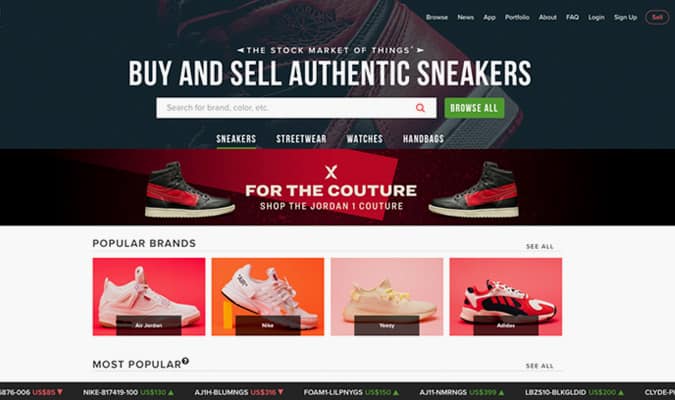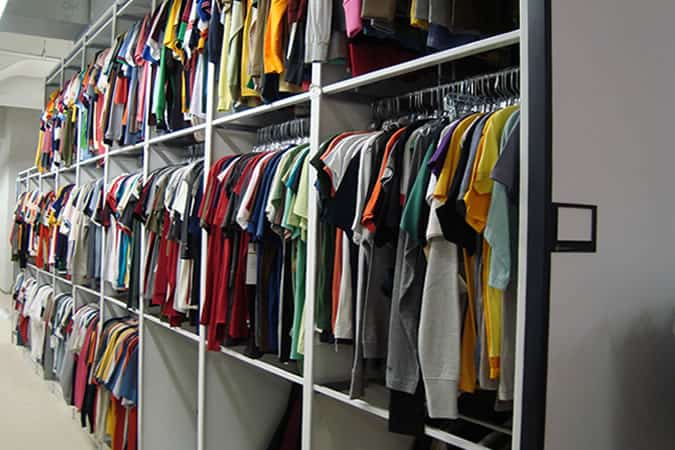Complete Guide To Sell Clothes Online - 9 minutes read
A full wardrobe might seem like a nice problem to have, but it’s no good if it’s loaded with the wrong stuff. Sure, you could send everything to landfill or cart the lot to the charity shop, but neither is going to help fund your new season style. So trim the excess and get back in the black by flogging what you don’t wear with this complete guide to sell clothes online.
The Best Online Stores To Sell Your Clothes
Best For Sneakerheads: StockX
The likely result of Jordan Belfort getting in a room with a load of streetwear kids, StockX is described as “the world’s first stock market of things”. A goldmine of rare and deadstock sneakers, the site’s team inspects every pair to make sure whatever the buyer receives is authentic, meaning buyers are often willing to part with wads of cash.
How It Works: Grab a notepad for this bit. Once you’ve created a listing, you can wait for your crepes to explode like cryptocurrency before accepting the highest bid. But wait too long and offers can expire of be retracted. The alternative is to create a listing at a designated price. Once a buyer’s bid matches the price of the listed ‘Ask’, the transaction will automatically go through.
Commission: StockX selling fees vary between 8 and 9.5 percent dependent on what level of seller you are. The more you sell, the lower your fees. There is also a 3 percent processing fee for all sellers. stockx.com

Best For Designer Labels: Vestiaire Collective
Vestiaire Collective is dedicated exclusively to luxury fashion, and is big on names like Berluti and Gucci with a smattering of high-end skate brands mixed in. Ideal if you’re looking to clear some of that vintage Helmut Lang out of your walk-in wardrobe.
How it works: set up an account then photograph the pieces you want to sell. Post the pics with a brief description and the brand’s curation team will either approve or reject your post depending on the brand and item condition. When it sells, you ship to Vestiaire for free, they check the piece is genuine and in good nick, then pay you and post it on to the seller.
Commission: Varies. Below £45, you give up 34 percent of the sale price. But that drops to 18 percent for anything over £2,700. Or take advantage of its concierge service, which will collect your clothes in bulk, then photograph, post, sell and ship it all, before taking a cut starting from 25 percent. vestiairecollective.com
Best For Affordable Streetwear: Depop
This app-based market is a haven for affordable streetwear. Supreme, Palace and Nike are particularly well represented, but it’s also a good place to get rid of anything from Ralph Lauren Oxford shirts to worn-in Vans.
How it works: Snap a photo on your phone, price the piece and it’s live within seconds. People don’t rifle through your profile, so you need to list constantly to get an increase in activity. When someone buys, you ship straight to them. After 14 days, you get paid.
Commission: A flat 10 percent, plus a 2.5 percent transaction fee if you use the in-app Depop Wallet, or 3.4 percent if you sell through Paypal. depop.com

Best For Clothes Swapping: Hardy Ever Worn It
London-based resale platform Hardly Ever Worn It (also known as HEWI) is unique in that as well as offering the traditional buy-and-sell model, it offers user’s option to swap pieces in their wardrobe as payment. The site also occasionally links up with celebrities who’ve had a clear-out for charity, so you might just grab some of David Gandy’s garms.
How It Works: Each listing on HEWI must be approved by the site’s team before it goes live. Once an item is sold, payment is held until the buyer confirms receipt. In the case of swapping, list your item and wait for the offers to roll in. If what you’re selling is more expensive than what you’re being offered, you can add the difference in cash.
Commission: On HEWI, you’ll pay 15 percent + VAT of the final sale price of an item. However, the site does offer a free one-month trial with no commission for new users. hardlyeverwornit.com
Best For A Clearout: ASOS Marketplace
Fancy ditching the day job? Set up an online boutique through ASOS Marketplace, which will host your store and promote it to its audience. This isn’t one for an occasional clearout – you need at least 20 pieces stocked at all times if you’re going vintage, 10-15 for new brands.
How it works: This is essentially an online shop. First, apply. If you’re one of the few successful applicants, you then get your own customizable storefront to post your products. They need to adhere to ASOS’ Marketplace photography standards and if your stock level drops, you’ll be shut down.
Commission: £20 a month rent plus 20 percent on all sales. marketplace.asos.com

Best For Luxury Watches: Collector Square
For anyone who thinks buying second hand is just for high street cast-offs, think again. A go-to for the sale of pre-owned luxury goods, on Collector Square you’ll find everything from a vintage Louis Vuitton trunk to a Rolex Daytona. The platform even has a showroom based in Paris where potential buyers can browse your stock IRL.
How It Works: The lazy (read: rich) man’s option, Collector Square take care of everything for you. Complete an online valuation request and, if accepted, the Collector Square team will take care of collection, expert appraisal, photos, description and online upload, through to selling and shipment. All you have to do is sit back and wait for the money to hit your account.
Commission: There is no fee for offering an item for sale on Collector Square. However, the site takes 35 percent of the final sale price. collectorsquare.com/en/

Best For Rare Finds: eBay
The second-hand OG offers good returns, but you’re in a crowded marketplace. The auction format is best for rare or one-off pieces that are liable to spark a bidding war. Less so if you’re selling plain button-downs.
How it works: Photograph your items then post with an extensive item description. Either set a ‘Buy Now’ price or a kick-off point for the auction. Now wait.
Commission: 10 per cent of the total sale capped at £250, including shipping. ebay.com
Tips For Selling Your Clothes Online
Be Brutal With Your Wardrobe
Let’s get one thing straight, you are not Kim Kardashian. People are not clamouring for your cast-offs. Which means that if you’re ditching pieces for any reason besides changing taste, odds are you won’t find a buyer – only Yeezy can sell jumpers with holes in. Anything faded, stained or moth-eaten belongs in the bin. Of what remains, pull out anything you’ve not worn in the last year or which you can’t immediately picture in three separate outfits. Ditto for anything that doesn’t fit. If you’re struggling to let go, you might need a trial separation; stow pieces for a season to see if you miss them. And remember that if you find it tough to bid adieu to a piece, the more chance someone else will want it too. Their cash will soothe any parting pains.

Price Wisely
Although there’s a limit to how much cash you can expect. Near-new clothes can earn close to retail, but for anything more lived-in expect to take at least a 50 per cent hit. Which is still better than it languishing on the digital shelf. It’s all about your price point. Research before you price it. Look at forums, eBay. Search the product number and you’ll find the stockists on the Google Shopping app. People are savvy and they’re looking for the best deal. Apps like Depop encourage communication, so be willing to haggle.

Buy Smart
Throwaway fashion is precisely that. So don’t expect queues for your high street slogan T-shirts. Premium pieces, however, hold their value. Especially if they’re from an in-demand brand. And the better recognized the label, the more you can charge. Brands like Saint Laurent, Louis Vuitton, Dior and Gucci always have a high resale value.
If you take the plunge on a Saint Laurent leather jacket, you won’t just get a killer set of Tinder shots – when you decide to sell it on, you could get back three-quarters of what you paid. Which is (kind of) like getting a luxury piece for 75 percent off. It also helps to keep an eye on the industry. The arrival or departure of a creative director impacts interest and therefore tends to increase or decrease an item’s value. If you’ve got any Hedi Slimane for Saint Laurent, or Raf Simons for Dior, now’s the time to sell.

Have All The Accoutrements
That Hermès scarf is an excellent accessory. But when you come to sell it, the best accessory is its original receipt. It’s proof of purchase and authenticity. A service like Vestiaire Collective will authenticate every piece before it sells, but the receipt also means that you can sell on less rigorous platforms like eBay – which charge a lower commission – where fear of knock-offs prevents buyers spending big. It’s not just luxury where it pays to have all the original bits. Sneakers will depreciate if you don’t have the original box or label.
Use yours to store your shoes and you’ll not only keep your flat tidy, but make a tidy sum when you sell them on. Just make sure they stay in good nick. Double box all your shoes. It comes at your expense, but if you are the buyer, you wouldn’t want the box battered when it arrived. That extra investment is good news for your bottom line – a happy customer is a return customer.

Nail Your Pictures
A picture sells a thousand garms. Unless it’s a dark, grainy snap that makes a Lanvin blazer look like something from your dad’s wardrobe (and not in a good way). Not that you need to invest in a Testino-worthy studio. Just take things outside or near a window. Natural light and a plain background will do. Make sure it’s clean, tidy and that the product is the main focus. Apps like VSCO or Photoshop let you clean up pics, to brighten colors or get rid of glare. Just avoid filters – they’re good for the ‘Gram, less so when a buyer discovers their white Yeezy Boosts are actually brown.
